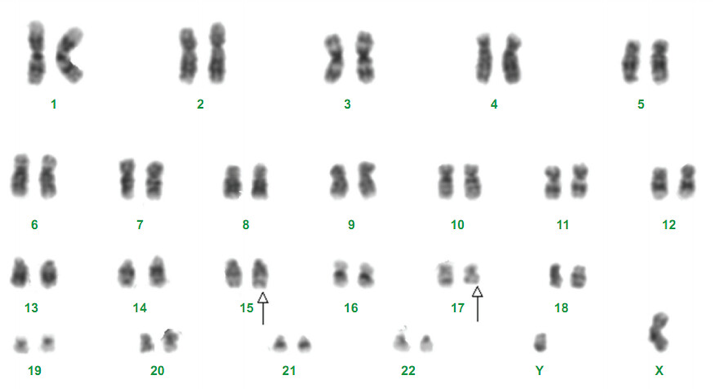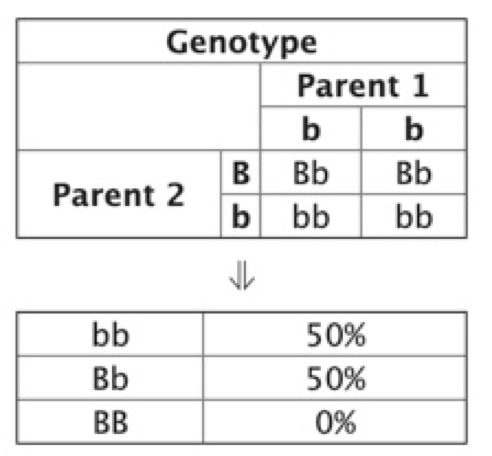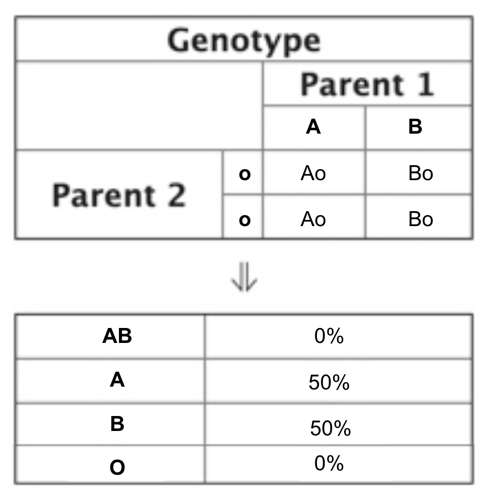How Can Punnett Squares Be Used to Help Predict Traits of Offspring?
Punnett squares
Know how to utilise a Punnett Square to predict inheritance for a monohybrid cross.
Vocab:
- Punnett square
- Monohybrid cross
- Cistron
- Allele
- Dominant alleles
- Recessive alleles
- Homozygous
- Heterozygous
A is a filigree formed by 4 squares to form a larger square. Scientists use this every bit a fashion to predict a trait or genotype that comes from two different people or organisms. Before talking about how to use a Punnett foursquare, the next important topic is alleles and the different types of alleles.

Each man cell has 23 pairs of chromosomes and each consists of hundreds of thousands of unlike genes. are used to pass traits from parent to offspring. An is a pair of genes on a chromosome that determine a hereditary trait.
With alleles, there are ii main types of alleles that are essential. A is one that will be more overpowering than some other allele and a is an allele that tin be overpowered by a dominant allele. Dominant alleles are represented by capital letters and recessive alleles are represented past lowercase letters. For example, blueish eyes are a recessive trait and brown eyes are a dominant trait. Therefore, if a female has blue eyes they tin can exist represented by "bb" and if a male has dark-brown eyes this can be represented as "BB" or "Bb". The reason why brown eyes can be represented as "Bb" is that the capital "B" is dominant over the lowercase "b". For the instance, assume that the male has the "Bb".
A is a cross betwixt 2 organisms with different variations of i trait. A Punnet square is a monohybrid cross and is going to be used to compare the traits of the case given earlier.
For traits that take either two capital letters or ii lowercase letters are known as a trait and for traits that have alternate letters are known as traits. In heterozygous alleles, the uppercase letter volition always come first.
To begin, write the 2 messages of the blueish-eyed female on top and the two letters of the dark-brown brown-eyed male person on the side. Side by side, nosotros're just going to match the letters downwardly each square and look at the possible outcomes if they had offspring.

As you can come across there is a fifty% chance that the homozygous recessive trait of blue eyes will be shown on their next kid, a l% chance that the heterozygous dominant trait of brown optics is given on the next offspring, and a 0% run a risk of a homozygous ascendant trait given to the offspring.
In some cases, there are ii ascendant alleles that are present and causes no blending. For example, if a bloom had the dominant allele of Red and the dominant allele of White the bloom petals volition show spots of red and white. This is called co-dominance. In the example of incomplete dominance, the flower would blend the 2 colors to course a pink petals.
Another example where nosotros tin can use a punnett square is with blood types. Let's say a female has a blood type of AB and a male has the blood type of O. Both A and B are considered co-dominant meaning that both the A and the B are present on the females blood cells. The O claret type is a recessive allele and for the punnett foursquare it will be written as "oo". Hither is a list of genotypes for each blood type.
| Blood Blazon | Genotype |
| A | AA or Ao |
| B | BB or Bo |
| AB | AB |
| O | oo |
Let's try to describe a punnett square with the AB female person and the O male person. Commencement we e'er begin by drawing the punnett square and writing the genotypes on the elevation and side. For our case, I will write the female on superlative and the male on the side.
Next, we will match the letters for each box on the punnett foursquare.

As you can see from the punnett square, the offspring of these 2 people would accept a 50% chance of the blood type A and a 50% chance of the blood type B. In this instance, both of these blood types would be heterozygous because the genotypes consist of the o allele.
Figure i Image Credit: "Figure 1" by Libertas Academica is licensed under CC Past ii.0
Figure two Paradigm Credit: "Genotype" by Annie Chen
Effigy 3 Image Credit: "Genotype2" by Annie Chen
Source: https://pressbooks.umn.edu/classroompartners/chapter/punnett-squares/
0 Response to "How Can Punnett Squares Be Used to Help Predict Traits of Offspring?"
Post a Comment